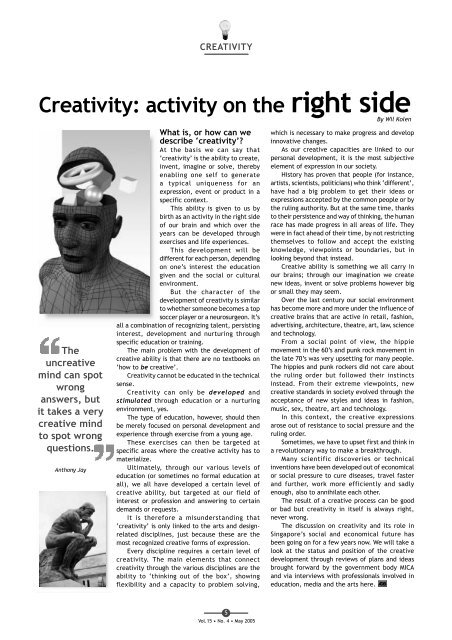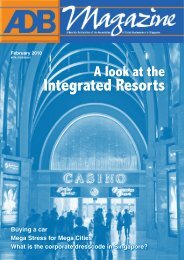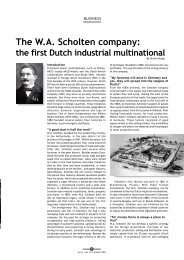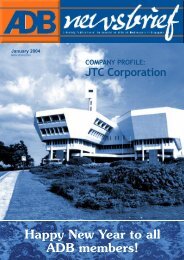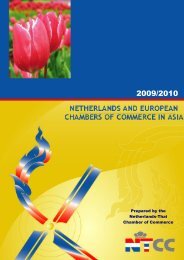ADB May - Association of Dutch Businessmen
ADB May - Association of Dutch Businessmen
ADB May - Association of Dutch Businessmen
Create successful ePaper yourself
Turn your PDF publications into a flip-book with our unique Google optimized e-Paper software.
CREATIVITY<br />
Creativity: activity on the right side<br />
By Wil Kolen<br />
The<br />
uncreative<br />
mind can spot<br />
wrong<br />
answers, but<br />
it takes a very<br />
creative mind<br />
to spot wrong<br />
questions.<br />
Anthony Jay<br />
What is, or how can we<br />
describe ‘creativity’?<br />
At the basis we can say that<br />
‘creativity’ is the ability to create,<br />
invent, imagine or solve, thereby<br />
enabling one self to generate<br />
a typical uniqueness for an<br />
expression, event or product in a<br />
specific context.<br />
This ability is given to us by<br />
birth as an activity in the right side<br />
<strong>of</strong> our brain and which over the<br />
years can be developed through<br />
exercises and life experiences.<br />
This development will be<br />
different for each person, depending<br />
on one’s interest the education<br />
given and the social or cultural<br />
environment.<br />
But the character <strong>of</strong> the<br />
development <strong>of</strong> creativity is similar<br />
to whether someone becomes a top<br />
soccer player or a neurosurgeon. It’s<br />
all a combination <strong>of</strong> recognizing talent, persisting<br />
interest, development and nurturing through<br />
specific education or training.<br />
The main problem with the development <strong>of</strong><br />
creative ability is that there are no textbooks on<br />
‘how to be creative’.<br />
Creativity cannot be educated in the technical<br />
sense.<br />
Creativity can only be developed and<br />
stimulated through education or a nurturing<br />
environment, yes.<br />
The type <strong>of</strong> education, however, should then<br />
be merely focused on personal development and<br />
experience through exercise from a young age.<br />
These exercises can then be targeted at<br />
specific areas where the creative activity has to<br />
materialize.<br />
Ultimately, through our various levels <strong>of</strong><br />
education (or sometimes no formal education at<br />
all), we all have developed a certain level <strong>of</strong><br />
creative ability, but targeted at our field <strong>of</strong><br />
interest or pr<strong>of</strong>ession and answering to certain<br />
demands or requests.<br />
It is therefore a misunderstanding that<br />
‘creativity’ is only linked to the arts and designrelated<br />
disciplines, just because these are the<br />
most recognized creative forms <strong>of</strong> expression.<br />
Every discipline requires a certain level <strong>of</strong><br />
creativity. The main elements that connect<br />
creativity through the various disciplines are the<br />
ability to ‘thinking out <strong>of</strong> the box’, showing<br />
flexibility and a capacity to problem solving,<br />
which is necessary to make progress and develop<br />
innovative changes.<br />
As our creative capacities are linked to our<br />
personal development, it is the most subjective<br />
element <strong>of</strong> expression in our society.<br />
History has proven that people (for instance,<br />
artists, scientists, politicians) who think ‘different’,<br />
have had a big problem to get their ideas or<br />
expressions accepted by the common people or by<br />
the ruling authority. But at the same time, thanks<br />
to their persistence and way <strong>of</strong> thinking, the human<br />
race has made progress in all areas <strong>of</strong> life. They<br />
were in fact ahead <strong>of</strong> their time, by not restricting<br />
themselves to follow and accept the existing<br />
knowledge, viewpoints or boundaries, but in<br />
looking beyond that instead.<br />
Creative ability is something we all carry in<br />
our brains; through our imagination we create<br />
new ideas, invent or solve problems however big<br />
or small they may seem.<br />
Over the last century our social environment<br />
has become more and more under the influence <strong>of</strong><br />
creative brains that are active in retail, fashion,<br />
advertising, architecture, theatre, art, law, science<br />
and technology.<br />
From a social point <strong>of</strong> view, the hippie<br />
movement in the 60’s and punk rock movement in<br />
the late 70’s was very upsetting for many people.<br />
The hippies and punk rockers did not care about<br />
the ruling order but followed their instincts<br />
instead. From their extreme viewpoints, new<br />
creative standards in society evolved through the<br />
acceptance <strong>of</strong> new styles and ideas in fashion,<br />
music, sex, theatre, art and technology.<br />
In this context, the creative expressions<br />
arose out <strong>of</strong> resistance to social pressure and the<br />
ruling order.<br />
Sometimes, we have to upset first and think in<br />
a revolutionary way to make a breakthrough.<br />
Many scientific discoveries or technical<br />
inventions have been developed out <strong>of</strong> economical<br />
or social pressure to cure diseases, travel faster<br />
and further, work more efficiently and sadly<br />
enough, also to annihilate each other.<br />
The result <strong>of</strong> a creative process can be good<br />
or bad but creativity in itself is always right,<br />
never wrong.<br />
The discussion on creativity and its role in<br />
Singapore’s social and economical future has<br />
been going on for a few years now. We will take a<br />
look at the status and position <strong>of</strong> the creative<br />
development through reviews <strong>of</strong> plans and ideas<br />
brought forward by the government body MICA<br />
and via interviews with pr<strong>of</strong>essionals involved in<br />
education, media and the arts here.<br />
5<br />
Vol.15 • No. 4 • <strong>May</strong> 2005


